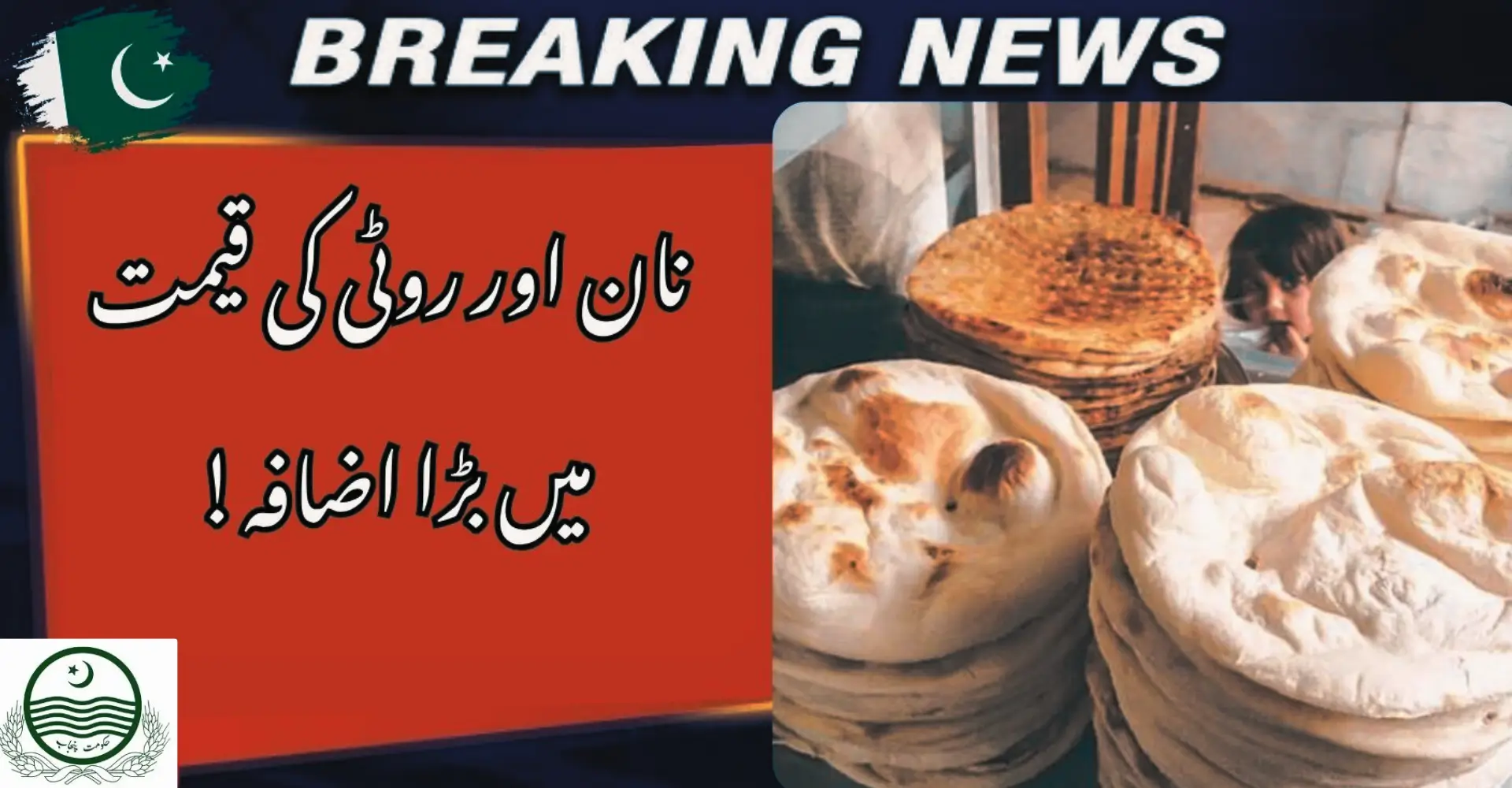Naan and Roti Prices Rise in Major Cities of Pakistan in 2025: What You Need to Know

Naan and Roti Prices Rise in Major Cities of Pakistan in 2025: What You Need to Know. The people of Lahore and other major cities in Pakistan are facing another surge in food prices. Recently, the Muttahida Nanbai Association announced a Rs5 increase in naan and khameeri roti, pushing prices to Rs30 each. This price hike has raised concerns among households that rely on these staple foods for daily meals. In this article, we’ll explore the reasons behind this rise, the government’s response, and what it means for families across Pakistan in 2025.
Why Are Naan and Roti Prices Rising?
Rising Cost of Flour (Maida)
The main driver behind the price hike is the rising cost of fine flour (maida). According to the Nanbai Association, the price of a standard flour sack has increased from Rs4,500 to Rs5,000, significantly impacting tandoor owners’ operating costs.
Factors contributing to the increase include:
- Rising gas prices for tandoor ovens
- Higher rent for bakery and tandoor shops
- Inflation in raw material prices, especially fine flour
Tandoor owners claim that maintaining previous prices of Rs25 per naan or roti has become unsustainable.
Association Meetings and Decisions
The Muttahida Nanbai Association stated that the decision was made after multiple meetings with tandoor shopkeepers. They also mentioned that if the government intervenes to stabilize flour prices, they are willing to lower the rates back to Rs25.
This highlights the direct link between inflation, raw material costs, and food pricing in Pakistan.
Government’s Reaction
Official Stance on Price Hike
The Punjab government has clarified that it has no role in the increase of fine flour prices. Officials emphasized that the government-approved rate of plain roti remains Rs14, and any increase beyond this rate is not sanctioned.
Monitoring and Public Awareness
Authorities have deployed teams to monitor bakeries and tandoors to ensure consumers are not overcharged. Citizens are encouraged to report overpricing incidents, helping the government enforce pricing regulations on essential food items.
Impact on Households and Daily Life
Effect on Family Budgets
For many Lahore households, naan and roti are daily necessities, forming a core part of meals. Even a small increase of Rs5 per piece can strain family budgets, especially in low-income households.
Public Concerns
Residents have expressed concerns over:
- Rising inflation in essential food items
- Increased household expenses for daily meals
- Potential domino effect on other food prices, as bakeries and tandoors adjust for costs
The price rise has sparked debates on whether the government should regulate flour costs or provide subsidies to tandoor owners.
Naan and Roti Prices Across Major Cities
Here’s a quick comparison of current naan and roti prices in key cities:
| City | Naan Price (Rs) | Khameeri Roti Price (Rs) | Plain Roti Price (Government Rate) |
|---|---|---|---|
| Lahore | 30 | 30 | 14 |
| Karachi | 28–30 | 28–30 | 14 |
| Islamabad | 30 | 30 | 14 |
| Peshawar | 25–28 | 25–28 | 14 |
| Multan | 27–30 | 27–30 | 14 |
Note: Prices vary slightly depending on local tandoor shops and supply chain fluctuations.
Factors Driving Flour and Food Inflation in Pakistan
Beyond local tandoor costs, several macro factors affect naan and roti prices:
1. Global Wheat Prices
Pakistan imports a portion of its wheat and flour. Global price hikes in wheat markets directly impact local flour costs, increasing tandoor expenses.
2. Energy Costs
Rising gas and electricity bills affect bakery and tandoor operations. Higher fuel costs are often passed on to consumers in the form of higher prices.
3. Supply Chain Disruptions
Delays in flour distribution, higher transportation costs, and logistical challenges also add to the overall food inflation.
4. Inflation and Currency Depreciation
With the Pakistani Rupee weakening, imported flour becomes costlier. This forces bakeries and tandoors to adjust their pricing to maintain profits.
How Consumers Can Respond
Residents of major cities can take practical steps to mitigate the impact:
Budget Planning
- Track household spending on staple foods like naan, roti, and flour
- Adjust meal plans to include economical alternatives when possible
Monitoring Prices
- Keep an eye on local tandoor rates
- Report overcharging to authorities using hotlines or consumer forums
Homemade Alternatives
- Prepare homemade roti or naan to avoid frequent purchases
- Use wheat flour alternatives or mix flours to reduce costs
Expert Opinion on Long-Term Trends
Food analysts predict that naan and roti prices may continue to rise if:
- Flour prices remain high
- Gas and electricity rates increase
- Global wheat supply fluctuates
Experts suggest the government may need to introduce subsidies for essential commodities or improve price monitoring to ensure affordable food for citizens.
FAQs
Q1: Why did naan and roti prices increase in Lahore in 2025?
A: The increase is mainly due to higher flour (maida) prices, along with rising costs of gas, rent, and bakery operations.
Q2: Are these price hikes government-approved?
A: No. The government has clarified that the approved rate for plain roti is Rs14. The price rise for naan and khameeri roti is imposed by tandoor owners.
Q3: Can the government lower the prices?
A: Yes. If flour prices are stabilized or subsidies provided, tandoor owners may reduce the rates back to previous levels.
Q4: How much is naan and roti in other cities of Pakistan?
A: Prices vary: Karachi Rs28–30, Islamabad Rs30, Peshawar Rs25–28, Multan Rs27–30, while government-approved plain roti is Rs14 across Pakistan.
Q5: What can households do to cope with rising prices?
A: Plan budgets, monitor tandoor rates, report overcharging, or make homemade roti/naan as an alternative.
Conclusion
The rise in naan and roti prices in Lahore and other major Pakistani cities reflects the broader challenges of inflation, rising flour costs, and tandoor operation expenses. While the government monitors pricing, households need to adapt through careful budgeting, reporting overcharging, and exploring homemade alternatives.










